Spliceosome protein EFTUD2: A potential pathogenetic factor in tumorigenesis and some developmental defects (Review)
- Authors:
- Ankang Yin
- Qiuyu Zhu
- Yi Chen
- Juan Wang
-
Affiliations: School of Medical Technology and Information Engineering, Zhejiang Chinese Medical University, Hangzhou, Zhejiang 310053, P.R. China, Department of Clinical Laboratory, Tongde Hospital Affiliated to Zhejiang Chinese Medical University (Tongde Hospital of Zhejiang Province), Hangzhou, Zhejiang 310012, P.R. China - Published online on: March 19, 2025 https://doi.org/10.3892/mmr.2025.13499
- Article Number: 134
-
Copyright : © Yin et al. This is an open access article distributed under the terms of Creative Commons Attribution License [CC BY 4.0].
This article is mentioned in:
Abstract
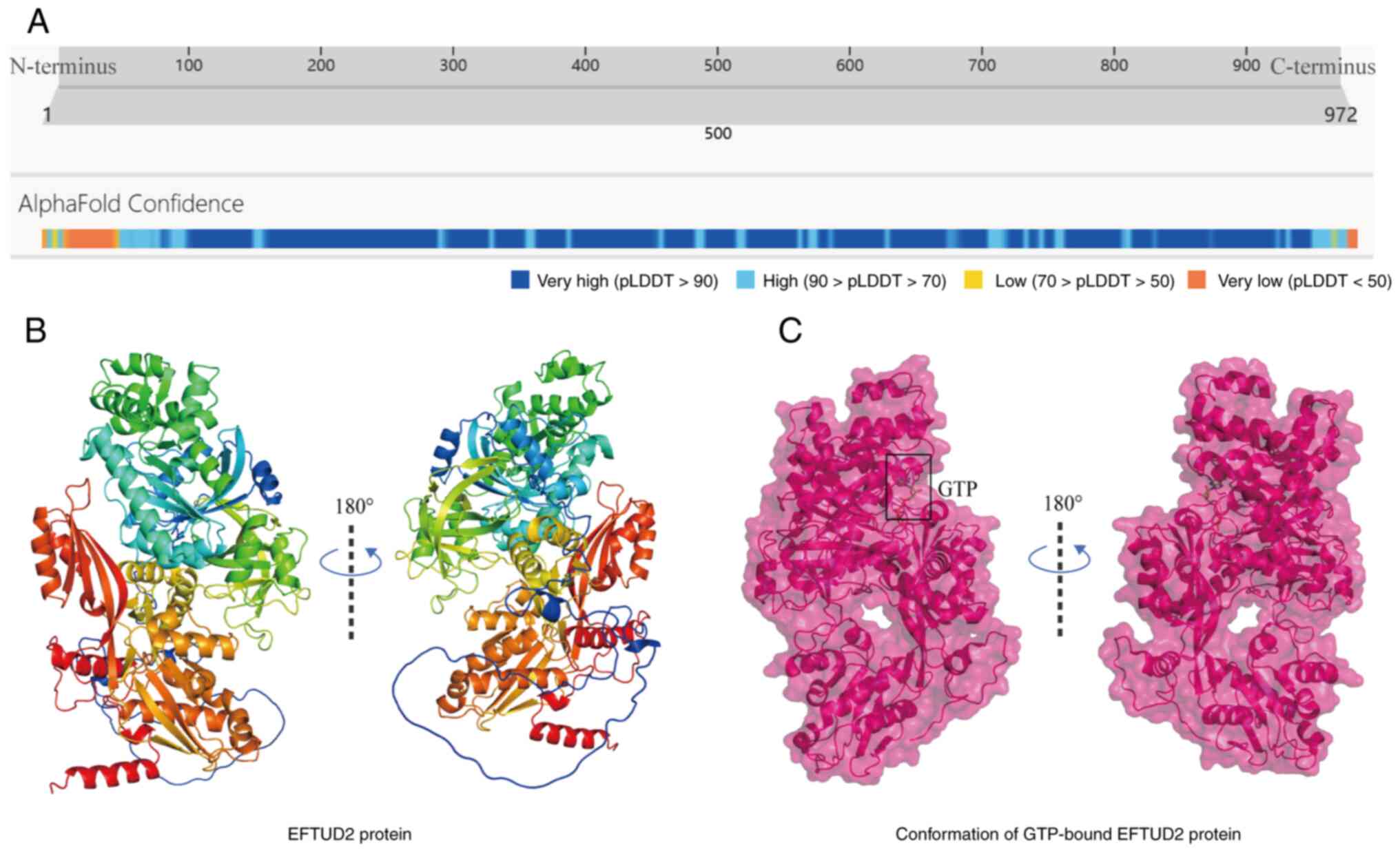 |
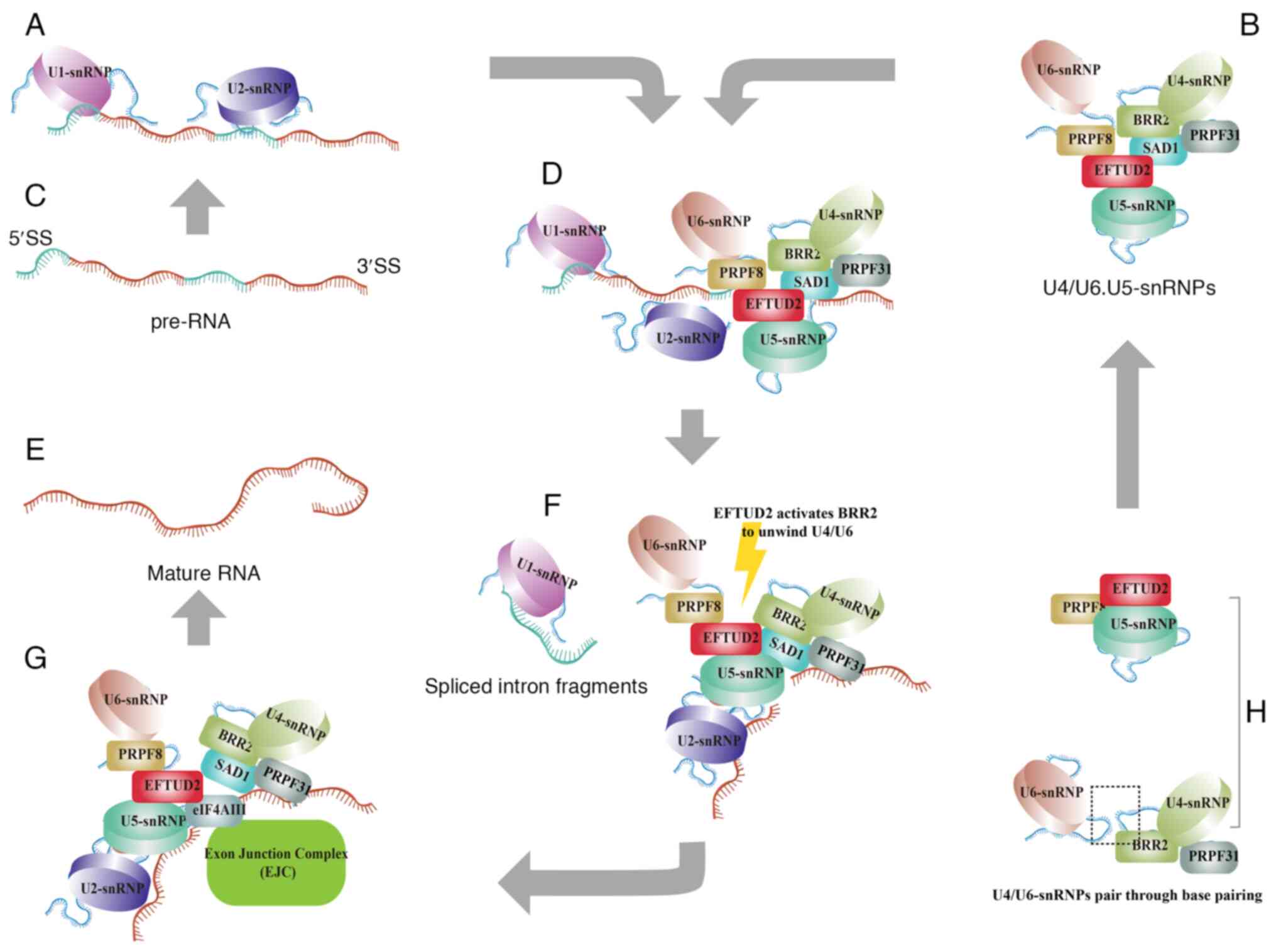 |
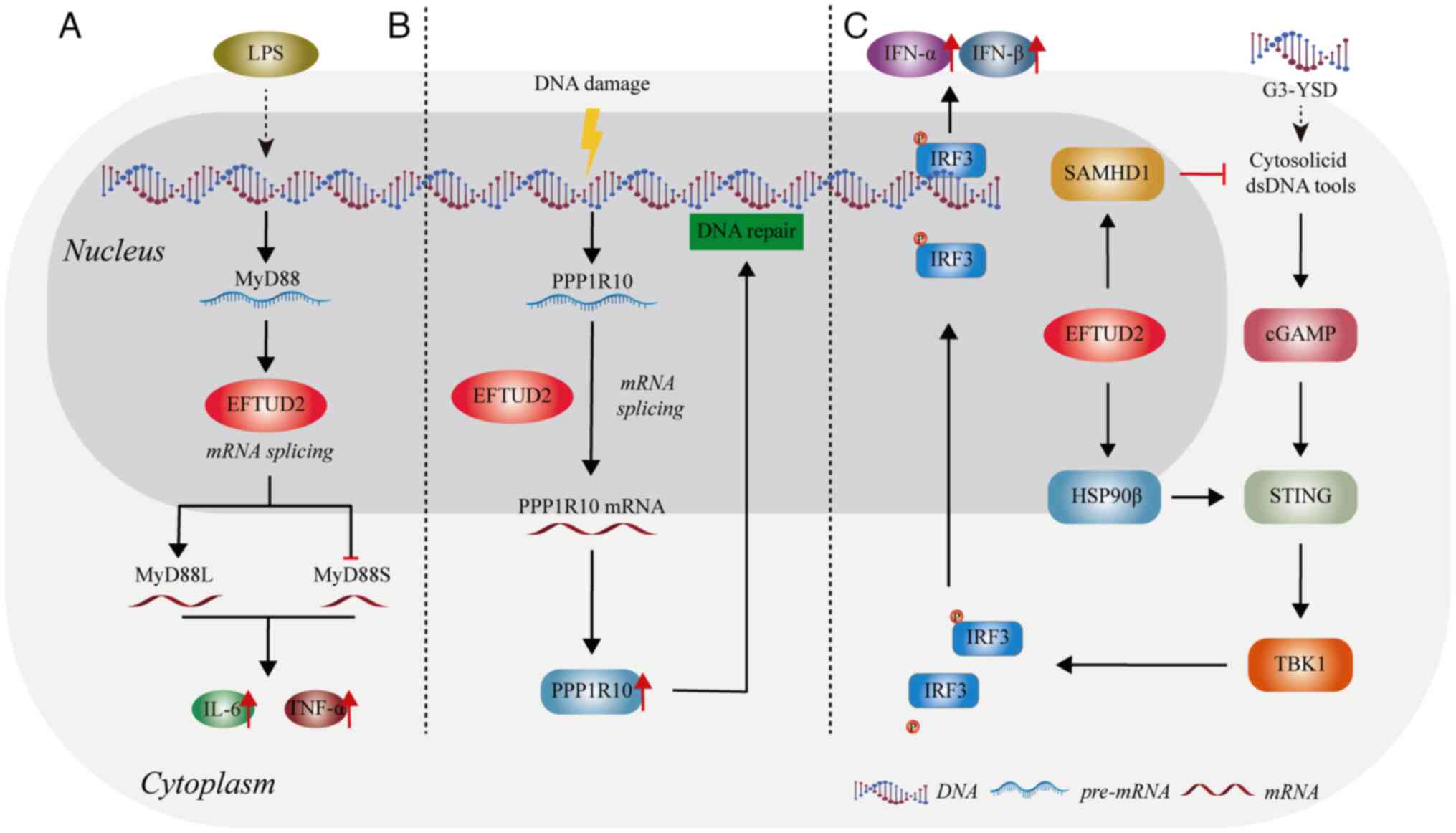 |
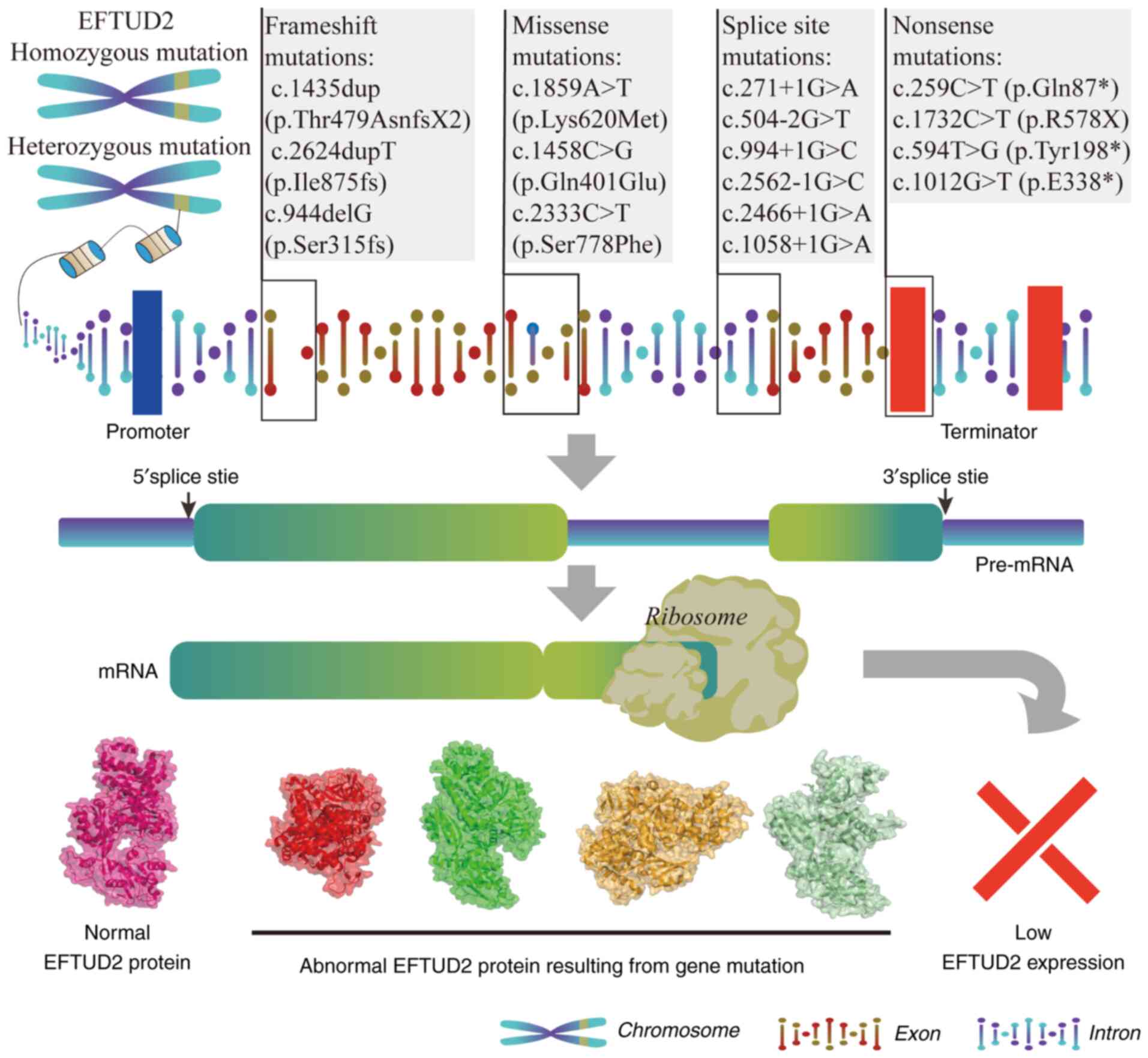 |
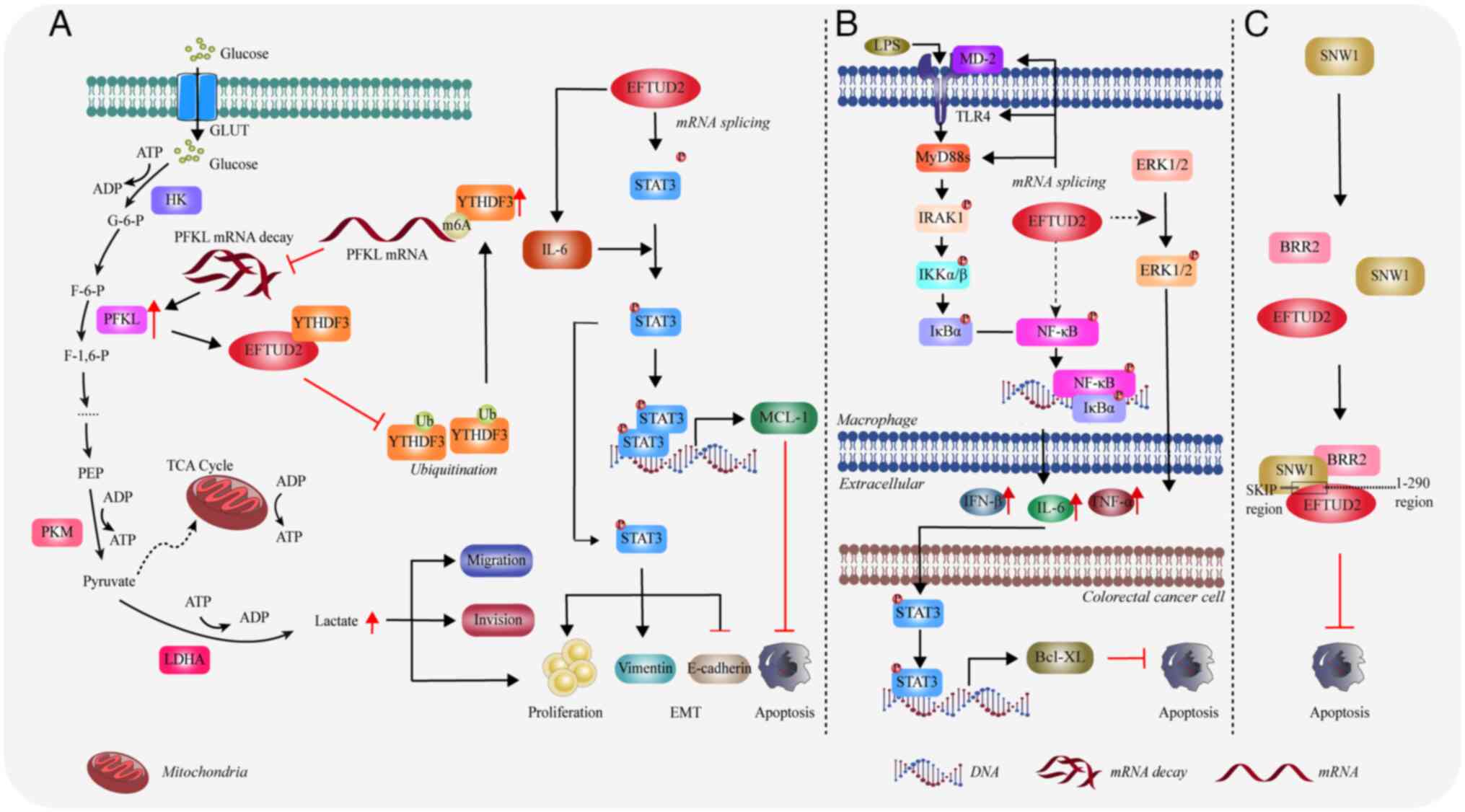 |
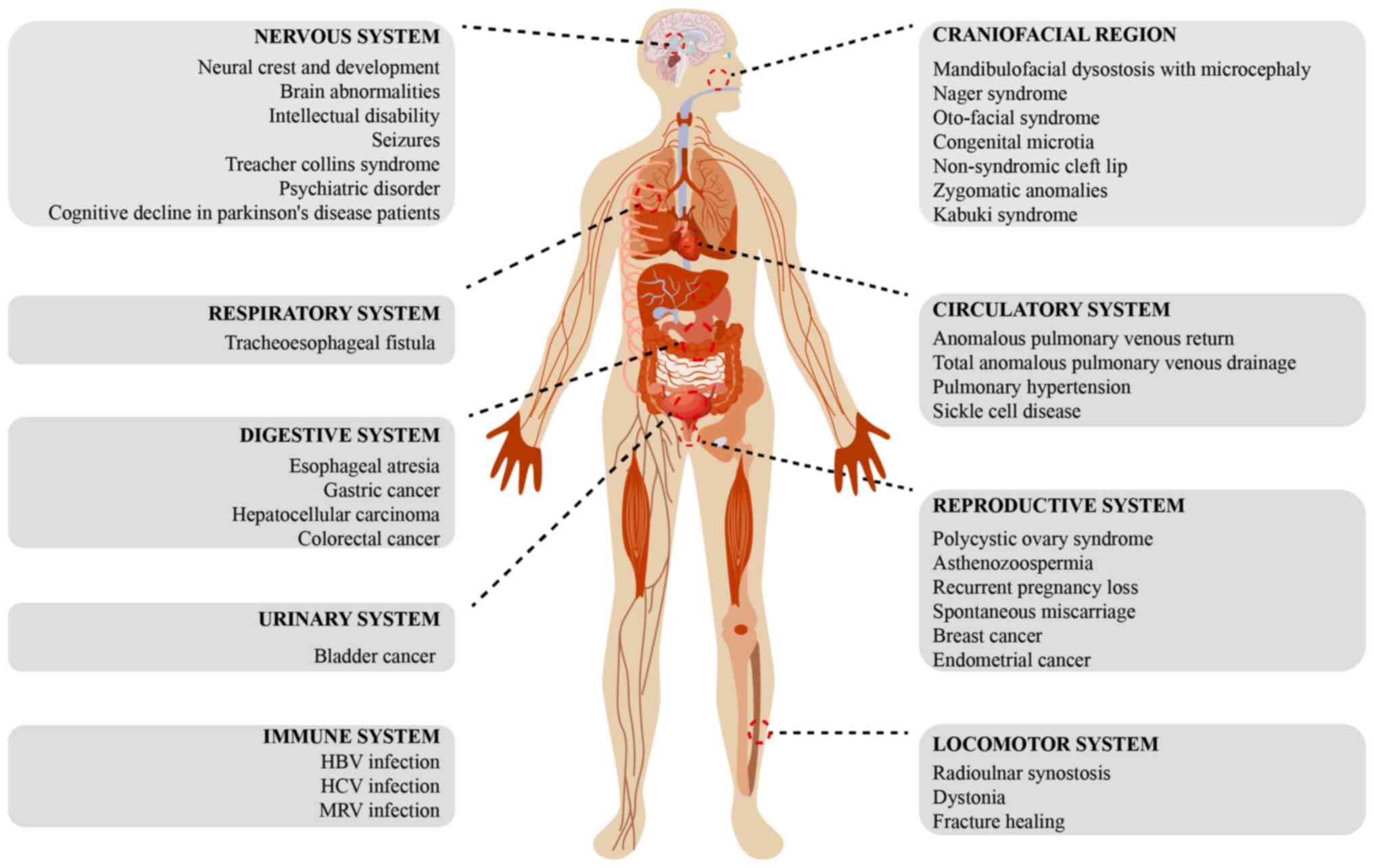 |
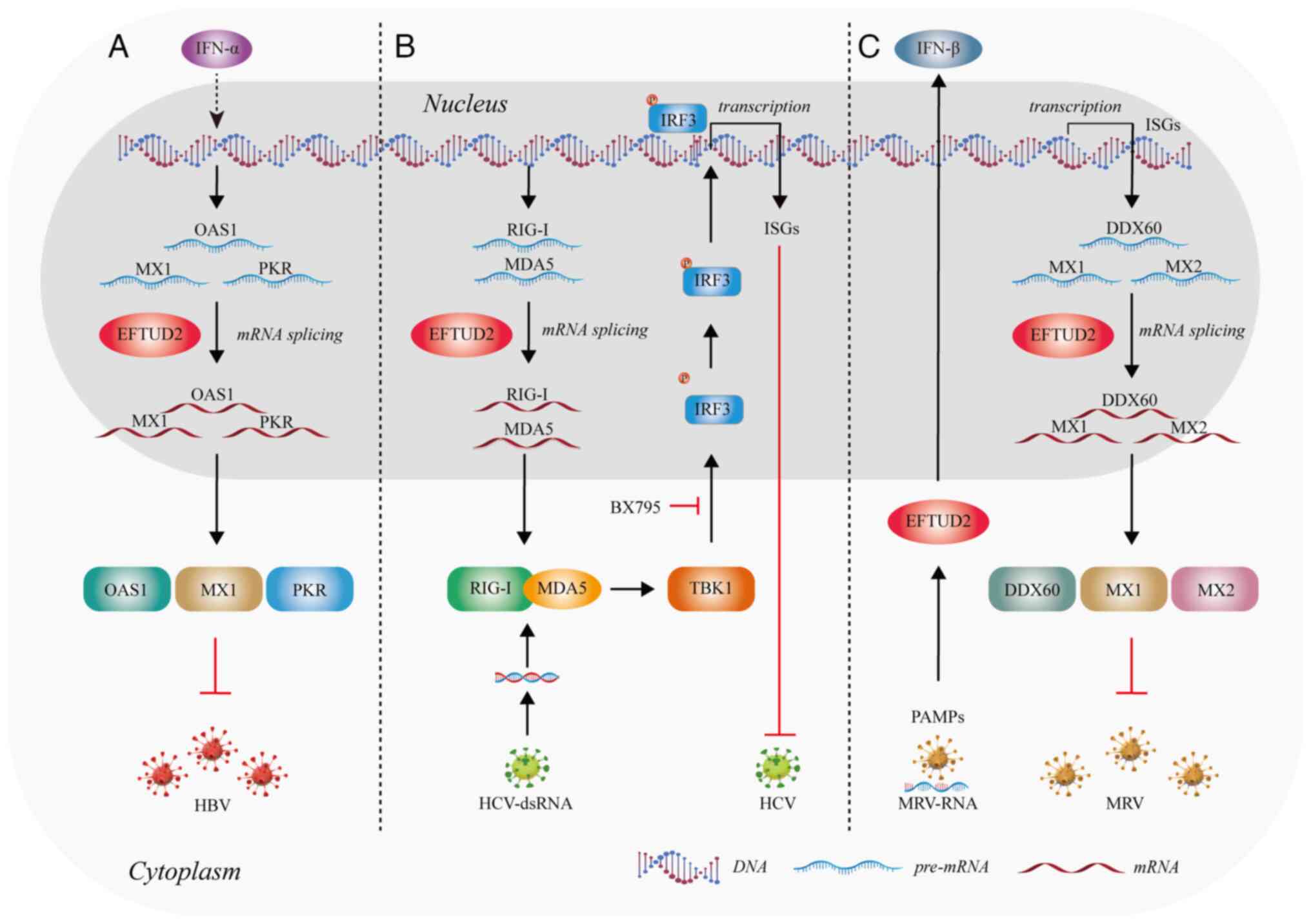 |
|
Gilbert W: Why genes in pieces? Nature. 271:5011978. View Article : Google Scholar : PubMed/NCBI | |
|
Jurica MS and Moore MJ: Pre-mRNA splicing: Awash in a sea of proteins. Mol Cell. 12:5–14. 2003. View Article : Google Scholar : PubMed/NCBI | |
|
Will CL and Luhrmann R: Spliceosome structure and function. Cold Spring Harb Perspect Biol. 3:a0037072011. View Article : Google Scholar : PubMed/NCBI | |
|
Boesler C, Rigo N, Anokhina MM, Tauchert MJ, Agafonov DE, Kastner B, Urlaub H, Ficner R, Will CL and Lührmann R: A spliceosome intermediate with loosely associated tri-snRNP accumulates in the absence of Prp28 ATPase activity. Nat Commun. 7:119972016. View Article : Google Scholar : PubMed/NCBI | |
|
Saez B, Walter MJ and Graubert TA: Splicing factor gene mutations in hematologic malignancies. Blood. 129:1260–1269. 2017. View Article : Google Scholar : PubMed/NCBI | |
|
Guo R, Zheng L, Park JW, Lv R, Chen H, Jiao F, Xu W, Mu S, Wen H, Qiu J, et al: BS69/ZMYND11 reads and connects histone H3.3 lysine 36 trimethylation-decorated chromatin to regulated pre-mRNA processing. Mol Cell. 56:298–310. 2014. View Article : Google Scholar : PubMed/NCBI | |
|
Zody MC, Garber M, Adams DJ, Sharpe T, Harrow J, Lupski JR, Nicholson C, Searle SM, Wilming L, Young SK, et al: DNA sequence of human chromosome 17 and analysis of rearrangement in the human lineage. Nature. 440:1045–1049. 2006. View Article : Google Scholar : PubMed/NCBI | |
|
Zahn-Zabal M, Michel PA, Gateau A, Nikitin F, Schaeffer M, Audot E, Gaudet P, Duek PD, Teixeira D, Rech de Laval V, et al: The neXtProt knowledgebase in 2020: Data, tools and usability improvements. Nucleic Acids Res. 48(D1): D328–D334. 2020.PubMed/NCBI | |
|
Fagerberg L, Hallstrom BM, Oksvold P, Kampf C, Djureinovic D, Odeberg J, Habuka M, Tahmasebpoor S, Danielsson A, Edlund K, et al: Analysis of the human tissue-specific expression by genome-wide integration of transcriptomics and antibody-based proteomics. Mol Cell Proteomics. 13:397–406. 2014. View Article : Google Scholar : PubMed/NCBI | |
|
Plaschka C, Newman AJ and Nagai K: Structural basis of nuclear pre-mRNA splicing: Lessons from yeast. Cold Spring Harb Perspect Biol. 11:a0323912019. View Article : Google Scholar : PubMed/NCBI | |
|
Papasaikas P and Valcarcel J: The spliceosome: The ultimate RNA chaperone and sculptor. Trends Biochem Sci. 41:33–45. 2016. View Article : Google Scholar : PubMed/NCBI | |
|
Gozani O, Feld R and Reed R: Evidence that sequence-independent binding of highly conserved U2 snRNP proteins upstream of the branch site is required for assembly of spliceosomal complex A. Genes Dev. 10:233–243. 1996. View Article : Google Scholar : PubMed/NCBI | |
|
Misra B, Wagner R and Boneval H: Injuries of hepatic veins and retrohepatic vena cava. Am Surg. 49:55–60. 1983.PubMed/NCBI | |
|
Agafonov DE, Kastner B, Dybkov O, Hofele RV, Liu WT, Urlaub H, Lührmann R and Stark H: Molecular architecture of the human U4/U6.U5 tri-snRNP. Science. 351:1416–1420. 2016. View Article : Google Scholar : PubMed/NCBI | |
|
Laggerbauer B, Achsel T and Luhrmann R: The human U5-200kD DEXH-box protein unwinds U4/U6 RNA duplices in vitro. Proc Natl Acad Sci USA. 95:4188–4192. 1998. View Article : Google Scholar : PubMed/NCBI | |
|
Maeder C, Kutach AK and Guthrie C: ATP-dependent unwinding of U4/U6 snRNAs by the Brr2 helicase requires the C terminus of Prp8. Nat Struct Mol Biol. 16:42–48. 2009. View Article : Google Scholar : PubMed/NCBI | |
|
Boehm V and Gehring NH: Exon junction complexes: Supervising the gene expression assembly line. Trends Genet. 32:724–735. 2016. View Article : Google Scholar : PubMed/NCBI | |
|
Zhang X, Yan C, Hang J, Finci LI, Lei J and Shi Y: An atomic structure of the human spliceosome. Cell. 169:918–929. e142017. View Article : Google Scholar : PubMed/NCBI | |
|
Park BY, Tachi-Duprat M, Ihewulezi C, Devotta A and Saint-Jeannet JP: The Core splicing factors EFTUD2, SNRPB and TXNL4A are essential for neural crest and craniofacial development. J Dev Biol. 10:292022. View Article : Google Scholar : PubMed/NCBI | |
|
Beauchamp MC, Djedid A, Bareke E, Merkuri F, Aber R, Tam AS, Lines MA, Boycott KM, Stirling PC, Fish JL, et al: Mutation in Eftud2 causes craniofacial defects in mice via mis-splicing of Mdm2 and increased P53. Hum Mol Genet. 30:739–757. 2021. View Article : Google Scholar : PubMed/NCBI | |
|
Beauchamp MC, Djedid A, Daupin K, Clokie K, Kumar S, Majewski J and Jerome-Majewska LA: Loss of function mutation of Eftud2, the gene responsible for mandibulofacial dysostosis with microcephaly (MFDM), leads to pre-implantation arrest in mouse. PLoS One. 14:e02192802019. View Article : Google Scholar : PubMed/NCBI | |
|
Janeway CA Jr and Medzhitov R: Innate immune recognition. Annu Rev Immunol. 20:197–216. 2002. View Article : Google Scholar : PubMed/NCBI | |
|
De Arras L, Laws R, Leach SM, Pontis K, Freedman JH, Schwartz DA and Alper S: Comparative genomics RNAi screen identifies Eftud2 as a novel regulator of innate immunity. Genetics. 197:485–496. 2014. View Article : Google Scholar : PubMed/NCBI | |
|
White CR, Dungan M and Carrithers MD: Activation of human macrophage sodium channels regulates RNA processing to increase expression of the DNA repair protein PPP1R10. Immunobiology. 224:80–93. 2019. View Article : Google Scholar : PubMed/NCBI | |
|
Sun J, Li L, Hu J, Gao Y, Song J, Zhang X and Hu H: Time-course RNA-Seq profiling reveals isoform-level gene expression dynamics of the cGAS-STING pathway. Comput Struct Biotechnol J. 20:6490–6500. 2022. View Article : Google Scholar : PubMed/NCBI | |
|
Yang S, Zhao M and Jia S: Macrophage: Key player in the pathogenesis of autoimmune diseases. Front Immunol. 14:10803102023. View Article : Google Scholar : PubMed/NCBI | |
|
Kawai T and Akira S: The role of pattern-recognition receptors in innate immunity: Update on Toll-like receptors. Nat Immunol. 11:373–384. 2010. View Article : Google Scholar : PubMed/NCBI | |
|
Mendoza-Barbera E, Corral-Rodriguez MA, Soares-Schanoski A, Velarde M, Macieira S, Messerschmidt A, López-Collazo E and Fuentes-Prior P: Contribution of globular death domains and unstructured linkers to MyD88.IRAK-4 heterodimer formation: An explanation for the antagonistic activity of MyD88s. Biochem Biophys Res Commun. 380:183–187. 2009. View Article : Google Scholar : PubMed/NCBI | |
|
Hu MM and Shu HB: Innate immune response to cytoplasmic DNA: Mechanisms and diseases. Annu Rev Immunol. 38:79–98. 2020. View Article : Google Scholar : PubMed/NCBI | |
|
Maelfait J, Bridgeman A, Benlahrech A, Cursi C and Rehwinkel J: Restriction by SAMHD1 Limits cGAS/STING-dependent innate and adaptive immune responses to HIV-1. Cell Rep. 16:1492–1501. 2016. View Article : Google Scholar : PubMed/NCBI | |
|
Sato S, Li K, Sakurai N, Hashizume M, Baidya S, Nonaka H, Noguchi K, Ishikawa K, Obuse C and Takaoka A: Regulation of an adaptor protein STING by Hsp90β to enhance innate immune responses against microbial infections. Cell Immunol. 356:1041882020. View Article : Google Scholar : PubMed/NCBI | |
|
Sarkar A, Emrick LT, Smith EM, Austin EG, Yang Y, Hunter JV, Scaglia F and Lalani SR: Novel de novo mutations in EFTUD2 detected by exome sequencing in mandibulofacial dysostosis with Microcephaly syndrome. Am J Med Genet A. 167A:914–918. 2015. View Article : Google Scholar : PubMed/NCBI | |
|
Smigiel R, Bezniakow N, Jakubiak A, Błoch M, Patkowski D, Obersztyn E and Sasiadek MM: Phenotype analysis of Polish patients with mandibulofacial dysostosis type Guion-Almeida associated with esophageal atresia and choanal atresia caused by EFTUD2 gene mutations. J Appl Genet. 56:199–204. 2015. View Article : Google Scholar : PubMed/NCBI | |
|
Matsuo M, Yamauchi A, Ito Y, Sakauchi M, Yamamoto T, Okamoto N, Tsurusaki Y, Miyake N, Matsumoto N and Saito K: Mandibulofacial dysostosis with microcephaly: A case presenting with seizures. Brain Dev. 39:177–181. 2017. View Article : Google Scholar : PubMed/NCBI | |
|
Narumi-Kishimoto Y, Ozawa H, Yanagi K, Kawai T, Okamura K, Hata K, Kaname T and Matsubara Y: A novel EFTUD2 mutation identified an adult male with mandibulofacial dysostosis Guion-Almeida type. Clin Dysmorphol. 29:186–188. 2020. View Article : Google Scholar : PubMed/NCBI | |
|
McDermott JH, Study DD and Clayton-Smith J: Sibling recurrence of total anomalous pulmonary venous drainage. Eur J Med Genet. 60:265–267. 2017. View Article : Google Scholar : PubMed/NCBI | |
|
Wang J, Ahimaz PR, Hashemifar S, Khlevner J, Picoraro JA, Middlesworth W, Elfiky MM, Que J, Shen Y and Chung WK: Novel candidate genes in esophageal atresia/tracheoesophageal fistula identified by exome sequencing. Eur J Hum Genet. 29:122–130. 2021. View Article : Google Scholar : PubMed/NCBI | |
|
Khattar D and Suhrie KR: Esophageal atresia with or without tracheoesophageal fistula: Comorbidities, genetic evaluations and neonatal outcomes. Cureus. 15:e347792023.PubMed/NCBI | |
|
Bukowska-Olech E, Materna-Kiryluk A, Walczak-Sztulpa J, Popiel D, Badura-Stronka M, Koczyk G, Dawidziuk A and Jamsheer A: Targeted Next-generation sequencing in the diagnosis of facial dysostoses. Front Genet. 11:5804772020. View Article : Google Scholar : PubMed/NCBI | |
|
Lines MA, Huang L, Schwartzentruber J, Douglas SL, Lynch DC, Beaulieu C, Guion-Almeida ML, Zechi-Ceide RM, Gener B, Gillessen-Kaesbach G, et al: Haploinsufficiency of a spliceosomal GTPase encoded by EFTUD2 causes mandibulofacial dysostosis with microcephaly. Am J Hum Genet. 90:369–377. 2012. View Article : Google Scholar : PubMed/NCBI | |
|
Lacour JC, McBride L, St Hilaire H, Mundinger GS, Moses M, Koon J, Torres JI and Lacassie Y: Novel de novo EFTUD2 Mutations in 2 Cases With MFDM, initially suspected to have alternative craniofacial diagnoses. Cleft Palate Craniofac J. 56:674–678. 2019. View Article : Google Scholar : PubMed/NCBI | |
|
Luquetti DV, Hing AV, Rieder MJ, Nickerson DA, Turner EH, Smith J, Park S and Cunningham ML: ‘Mandibulofacial dysostosis with microcephaly’ caused by EFTUD2 mutations: Expanding the phenotype. Am J Med Genet A. 161A:108–113. 2013. View Article : Google Scholar : PubMed/NCBI | |
|
Kim SY, Lee DH, Han JH and Choi BY: Novel splice site pathogenic variant of EFTUD2 is associated with mandibulofacial dysostosis with microcephaly and extracranial symptoms in Korea. Diagnostics (Basel). 10:2962020. View Article : Google Scholar : PubMed/NCBI | |
|
Voigt C, Megarbane A, Neveling K, Czeschik JC, Albrecht B, Callewaert B, von Deimling F, Hehr A, Falkenberg Smeland M, König R, et al: Oto-facial syndrome and esophageal atresia, intellectual disability and zygomatic anomalies-expanding the phenotypes associated with EFTUD2 mutations. Orphanet J Rare Dis. 8:1102013. View Article : Google Scholar : PubMed/NCBI | |
|
Rengasamy Venugopalan S, Farrow EG and Lypka M: Whole-exome sequencing identified a variant in EFTUD2 gene in establishing a genetic diagnosis. Orthod Craniofac Res. 20 (Suppl 1):S50–S56. 2017. View Article : Google Scholar : PubMed/NCBI | |
|
Yang M, Sun H, Liu Y and Hu T: Whole exome sequencing revealed a heterozygous elongation factor Tu GTP-binding domain containing 2 (EFTUD2) mutation in a couple experiencing recurrent pregnancy loss. Chin Med J (Engl). 135:1108–1110. 2022. View Article : Google Scholar : PubMed/NCBI | |
|
Tu M, He L, You Y, Li J, Yao N, Qu C, Huang W, Xu L, Luo R and Hong J: EFTUD2 maintains the survival of tumor cells and promotes hepatocellular carcinoma progression via the activation of STAT3. Cell Death Dis. 11:8302020. View Article : Google Scholar : PubMed/NCBI | |
|
Lv C, Li XJ, Hao LX, Zhang S, Song Z, Ji XD and Gong B: Over-activation of EFTUD2 correlates with tumor propagation and poor survival outcomes in hepatocellular carcinoma. Clin Transl Oncol. 24:93–103. 2022. View Article : Google Scholar : PubMed/NCBI | |
|
Zhou R, Ni W, Qin C, Zhou Y, Li Y, Huo J, Bian L, Zhou A and Li J: A functional loop between YTH domain family protein YTHDF3 mediated m(6)A modification and phosphofructokinase PFKL in glycolysis of hepatocellular carcinoma. J Exp Clin Cancer Res. 41:3342022. View Article : Google Scholar : PubMed/NCBI | |
|
Johnson DE, O'Keefe RA and Grandis JR: Targeting the IL-6/JAK/STAT3 signalling axis in cancer. Nat Rev Clin Oncol. 15:234–248. 2018. View Article : Google Scholar : PubMed/NCBI | |
|
Zhou W, Chen Y, Luo R, Li Z, Jiang G and Ou X: Identification of biomarkers related to immune cell infiltration in hepatocellular carcinoma using gene co-expression network. Pathol Oncol Res. 27:6016932021. View Article : Google Scholar : PubMed/NCBI | |
|
Lv Z, Wang Z, Luo L, Chen Y, Han G, Wang R, Xiao H, Li X, Hou C, Feng J, et al: Spliceosome protein Eftud2 promotes colitis-associated tumorigenesis by modulating inflammatory response of macrophage. Mucosal Immunol. 12:1164–1173. 2019. View Article : Google Scholar : PubMed/NCBI | |
|
Fukata M, Chen A, Vamadevan AS, Cohen J, Breglio K, Krishnareddy S, Hsu D, Xu R, Harpaz N, Dannenberg AJ, et al: Toll-like receptor-4 promotes the development of colitis-associated colorectal tumors. Gastroenterology. 133:1869–1881. 2007. View Article : Google Scholar : PubMed/NCBI | |
|
Grivennikov S, Karin E, Terzic J, Mucida D, Yu GY, Vallabhapurapu S, Scheller J, Rose-John S, Cheroutre H, Eckmann L and Karin M: IL-6 and Stat3 are required for survival of intestinal epithelial cells and development of colitis-associated cancer. Cancer Cell. 15:103–113. 2009. View Article : Google Scholar : PubMed/NCBI | |
|
Popivanova BK, Kitamura K, Wu Y, Kondo T, Kagaya T, Kaneko S, Oshima M, Fujii C and Mukaida N: Blocking TNF-alpha in mice reduces colorectal carcinogenesis associated with chronic colitis. J Clin Invest. 118:560–570. 2008.PubMed/NCBI | |
|
Matsumoto S, Hara T, Mitsuyama K, Yamamoto M, Tsuruta O, Sata M, Scheller J, Rose-John S, Kado S and Takada T: Essential roles of IL-6 trans-signaling in colonic epithelial cells, induced by the IL-6/soluble-IL-6 receptor derived from lamina propria macrophages, on the development of colitis-associated premalignant cancer in a murine model. J Immunol. 184:1543–1551. 2010. View Article : Google Scholar : PubMed/NCBI | |
|
Ramesh P, Lannagan TRM, Jackstadt R, Atencia Taboada L, Lansu N, Wirapati P, van Hooff SR, Dekker D, Pritchard J, Kirov AB, et al: BCL-XL is crucial for progression through the adenoma-to-carcinoma sequence of colorectal cancer. Cell Death Differ. 28:3282–3296. 2021. View Article : Google Scholar : PubMed/NCBI | |
|
Hashimoto K, Nishimura S, Shinyashiki Y, Ito T and Akagi M: Characterizing inflammatory markers in highly aggressive soft tissue sarcomas. Medicine (Baltimore). 101:e306882022. View Article : Google Scholar : PubMed/NCBI | |
|
Guo G, Wang Y, Zhou Y, Quan Q, Zhang Y, Wang H, Zhang B and Xia L: Immune cell concentrations among the primary tumor microenvironment in colorectal cancer patients predicted by clinicopathologic characteristics and blood indexes. J Immunother Cancer. 7:1792019. View Article : Google Scholar : PubMed/NCBI | |
|
Yu L, Jiang R, Chen W, Liu Y, Wang G, Gong X and Wang Y: Novel prognostic indicator combining inflammatory indicators and tumor markers for gastric cancer. World J Surg Oncol. 21:502023. View Article : Google Scholar : PubMed/NCBI | |
|
Sato N, Maeda M, Sugiyama M, Ito S, Hyodo T, Masuda A, Tsunoda N, Kokuryo T, Hamaguchi M, Nagino M and Senga T: Inhibition of SNW1 association with spliceosomal proteins promotes apoptosis in breast cancer cells. Cancer Med. 4:268–277. 2015. View Article : Google Scholar : PubMed/NCBI | |
|
Albers M, Diment A, Muraru M, Russell CS and Beggs JD: Identification and characterization of Prp45p and Prp46p, essential pre-mRNA splicing factors. RNA. 9:138–150. 2003. View Article : Google Scholar : PubMed/NCBI | |
|
Chen F, Wang Q and Zhou Y: The construction and validation of an RNA binding protein-related prognostic model for bladder cancer. BMC Cancer. 21:2442021. View Article : Google Scholar : PubMed/NCBI | |
|
Beyer S, Muller L, Mitter S, Keilmann L, Meister S, Buschmann C, Kraus F, Topalov NE, Czogalla B, Trillsch F, et al: High RIG-I and EFTUD2 expression predicts poor survival in endometrial cancer. J Cancer Res Clin Oncol. 149:4293–4303. 2023. View Article : Google Scholar : PubMed/NCBI | |
|
Wieczorek D: Human facial dysostoses. Clin Genet. 83:499–510. 2013. View Article : Google Scholar : PubMed/NCBI | |
|
Wood KA, Eadsforth MA, Newman WG and O'Keefe RT: The Role of the U5 snRNP in genetic disorders and cancer. Front Genet. 12:6366202021. View Article : Google Scholar : PubMed/NCBI | |
|
Griffin C and Saint-Jeannet JP: Spliceosomopathies: Diseases and mechanisms. Dev Dyn. 249:1038–1046. 2020. View Article : Google Scholar : PubMed/NCBI | |
|
Lehalle D, Wieczorek D, Zechi-Ceide RM, Passos-Bueno MR, Lyonnet S, Amiel J and Gordon CT: A review of craniofacial disorders caused by spliceosomal defects. Clin Genet. 88:405–415. 2015. View Article : Google Scholar : PubMed/NCBI | |
|
Guion-Almeida ML, Zechi-Ceide RM, Vendramini S and Ju Nior AT: A new syndrome with growth and mental retardation, mandibulofacial dysostosis, microcephaly and cleft palate. Clin Dysmorphol. 15:171–174. 2006. View Article : Google Scholar : PubMed/NCBI | |
|
Abell K, Hopkin RJ, Bender PL, Jackson F, Smallwood K, Sullivan B, Stottmann RW, Saal HM and Weaver KN: Mandibulofacial dysostosis with microcephaly: An expansion of the phenotype via parental survey. Am J Med Genet A. 185:413–423. 2021. View Article : Google Scholar : PubMed/NCBI | |
|
Silva JB, Soares D, Leao M and Santos H: Mandibulofacial dysostosis with microcephaly: A syndrome to remember. BMJ Case Rep. 12:e2298312019. View Article : Google Scholar : PubMed/NCBI | |
|
Yu KPT, Luk HM, Gordon CT, Fung G, Oufadem M, Garcia-Barcelo MM, Amiel J, Chung BHY, Lo IFM and Tiong YT: Mandibulofacial dysostosis Guion-Almeida type caused by novel EFTUD2 splice site variants in two Asian children. Clin Dysmorphol. 27:31–35. 2018. View Article : Google Scholar : PubMed/NCBI | |
|
Huang L, Vanstone MR, Hartley T, Osmond M, Barrowman N, Allanson J, Baker L, Dabir TA, Dipple KM, Dobyns WB, et al: Mandibulofacial dysostosis with microcephaly: Mutation and database update. Hum Mutat. 37:148–154. 2016. View Article : Google Scholar : PubMed/NCBI | |
|
Vincent M, Genevieve D, Ostertag A, Marlin S, Lacombe D, Martin-Coignard D, Coubes C, David A, Lyonnet S, Vilain C, et al: Treacher collins syndrome: A clinical and molecular study based on a large series of patients. Genet Med. 18:49–56. 2016. View Article : Google Scholar : PubMed/NCBI | |
|
Need AC, Shashi V, Hitomi Y, Schoch K, Shianna KV, McDonald MT, Meisler MH and Goldstein DB: Clinical application of exome sequencing in undiagnosed genetic conditions. J Med Genet. 49:353–361. 2012. View Article : Google Scholar : PubMed/NCBI | |
|
Park CY, Zhou J, Wong AK, Chen KM, Theesfeld CL, Darnell RB and Troyanskaya OG: Genome-wide landscape of RNA-binding protein target site dysregulation reveals a major impact on psychiatric disorder risk. Nat Genet. 53:166–173. 2021. View Article : Google Scholar : PubMed/NCBI | |
|
Santiago JA and Potashkin JA: Blood biomarkers associated with cognitive decline in early stage and drug-naive Parkinson's disease patients. PLoS One. 10:e01425822015. View Article : Google Scholar : PubMed/NCBI | |
|
Wang S, Sun D, Liu C, Guo Y, Ma J, Ge RL and Cui S: Weighted gene co-expression network analysis reveals the hub genes associated with pulmonary hypertension. Exp Biol Med (Maywood). 248:217–231. 2023. View Article : Google Scholar : PubMed/NCBI | |
|
Liu L, Pertsemlidis A, Ding LH, Story MD, Steinberg MH, Sebastiani P, Hoppe C, Ballas SK and Pace BS: Original research: A case-control genome-wide association study identifies genetic modifiers of fetal hemoglobin in sickle cell disease. Exp Biol Med (Maywood). 241:706–718. 2016. View Article : Google Scholar : PubMed/NCBI | |
|
Gordon CT, Petit F, Oufadem M, Decaestecker C, Jourdain AS, Andrieux J, Malan V, Alessandri JL, Baujat G, Baumann C, et al: EFTUD2 haploinsufficiency leads to syndromic oesophageal atresia. J Med Genet. 49:737–746. 2012. View Article : Google Scholar : PubMed/NCBI | |
|
Heidarzadehpilehrood R, Pirhoushiaran M, Binti Osman M, Abdul Hamid H and Ling KH: Weighted gene co-expression network analysis (WGCNA) Discovered novel long non-coding RNAs for polycystic ovary syndrome. Biomedicines. 11:5182023. View Article : Google Scholar : PubMed/NCBI | |
|
Hou Y, Wang Y, Xu S, Qi G and Wu X: Bioinformatics identification of microRNAs involved in polycystic ovary syndrome based on microarray data. Mol Med Rep. 20:281–291. 2019.PubMed/NCBI | |
|
Li L and Chen S: Screening, identification and interaction analysis of key MicroRNAs and genes in Asthenozoospermia. Int J Med Sci. 18:1670–1679. 2021. View Article : Google Scholar : PubMed/NCBI | |
|
Czeschik JC, Voigt C, Alanay Y, Albrecht B, Avci S, Fitzpatrick D, Goudie DR, Hehr U, Hoogeboom AJ, Kayserili H, et al: Clinical and mutation data in 12 patients with the clinical diagnosis of Nager syndrome. Hum Genet. 132:885–898. 2013. View Article : Google Scholar : PubMed/NCBI | |
|
Zarate YA, Bell C and Schaefer GB: Radioulnar synostosis and brain abnormalities in a patient with 17q21.31 microdeletion involving EFTUD2. Cleft Palate Craniofac J. 52:237–239. 2015. View Article : Google Scholar : PubMed/NCBI | |
|
Zech M, Boesch S, Skorvanek M, Necpál J, Švantnerová J, Wagner M, Dincer Y, Sadr-Nabavi A, Serranová T, Rektorová I, et al: Clinically relevant copy-number variants in exome sequencing data of patients with dystonia. Parkinsonism Relat Disord. 84:129–134. 2021. View Article : Google Scholar : PubMed/NCBI | |
|
Tian A, Li Y, Fan H, Hu P, Xu R, Yuan H, Cai J, Zhang W, Yue M, Li J, et al: Association of elongation factor Tu GTP-binding Domain-containing 2 Gene (EFTUD2) polymorphism with the risk of hepatitis B virus infection. Immunol Invest. 51:1485–1497. 2022. View Article : Google Scholar : PubMed/NCBI | |
|
Hu P, Li Y, Zhang W, Liu R, Peng L, Xu R, Cai J, Yuan H, Feng T, Tian A, et al: The spliceosome factor EFTUD2 promotes IFN Anti-HBV effect through mRNA splicing. Mediators Inflamm. 2023:25462782023. View Article : Google Scholar : PubMed/NCBI | |
|
Sumpter R Jr, Loo YM, Foy E, Li K, Yoneyama M, Fujita T, Lemon SM and Gale M Jr: Regulating intracellular antiviral defense and permissiveness to hepatitis C virus RNA replication through a cellular RNA helicase, RIG-I. J Virol. 79:2689–2699. 2005. View Article : Google Scholar : PubMed/NCBI | |
|
Wang N, Liang Y, Devaraj S, Wang J, Lemon SM and Li K: Toll-like receptor 3 mediates establishment of an antiviral state against hepatitis C virus in hepatoma cells. J Virol. 83:9824–9834. 2009. View Article : Google Scholar : PubMed/NCBI | |
|
Zhu C, Xiao F, Hong J, Wang K, Liu X, Cai D, Fusco DN, Zhao L, Jeong SW, Brisac C, et al: EFTUD2 is a novel innate immune regulator restricting hepatitis C virus infection through the RIG-I/MDA5 pathway. J Virol. 89:6608–6618. 2015. View Article : Google Scholar : PubMed/NCBI | |
|
Metz P, Reuter A, Bender S and Bartenschlager R: Interferon-stimulated genes and their role in controlling hepatitis C virus. J Hepatol. 59:1331–1341. 2013. View Article : Google Scholar : PubMed/NCBI | |
|
Boudreault S, Lemay G and Bisaillon M: U5 snRNP core proteins are key components of the defense response against viral infection through their roles in programmed cell death and interferon induction. Viruses. 14:27102022. View Article : Google Scholar : PubMed/NCBI | |
|
Kawai T, Takahashi K, Sato S, Coban C, Kumar H, Kato H, Ishii KJ, Takeuchi O and Akira S: IPS-1, an adaptor triggering RIG-I- and Mda5-mediated type I interferon induction. Nat Immunol. 6:981–988. 2005. View Article : Google Scholar : PubMed/NCBI | |
|
Lau DT, Fish PM, Sinha M, Owen DM, Lemon SM and Gale M Jr: Interferon regulatory factor-3 activation, hepatic interferon-stimulated gene expression and immune cell infiltration in hepatitis C virus patients. Hepatology. 47:799–809. 2008. View Article : Google Scholar : PubMed/NCBI | |
|
Schoggins JW, Wilson SJ, Panis M, Murphy MY, Jones CT, Bieniasz P and Rice CM: A diverse range of gene products are effectors of the type I interferon antiviral response. Nature. 472:481–485. 2011. View Article : Google Scholar : PubMed/NCBI | |
|
Chi Q, Geng X, Xu K, Wang C and Zhao H: Potential targets and molecular mechanism of miR-331-3p in hepatocellular carcinoma identified by weighted gene coexpression network analysis. Biosci Rep. 40:BSR202001242020. View Article : Google Scholar : PubMed/NCBI | |
|
Zhang ZG, Shi ZD, Dong JJ, Chen YA, Cao MY, Li YT, Ma WM, Hao L, Pang K, Zhou JH, et al: Novel potential urinary biomarkers for effective diagnosis and prognostic evaluation of high-grade bladder cancer. Transl Cancer Res. 12:1992–2007. 2023. View Article : Google Scholar : PubMed/NCBI |










